Physical Address
304 North Cardinal St.
Dorchester Center, MA 02124
Physical Address
304 North Cardinal St.
Dorchester Center, MA 02124
Have you ever wanted to learn chess but felt overwhelmed by everything? You’re in luck, because today’s technology makes it easier than ever to start improving! In this guide, we’ll explore the best chess apps for beginners that will help you learn and improve at your own pace.
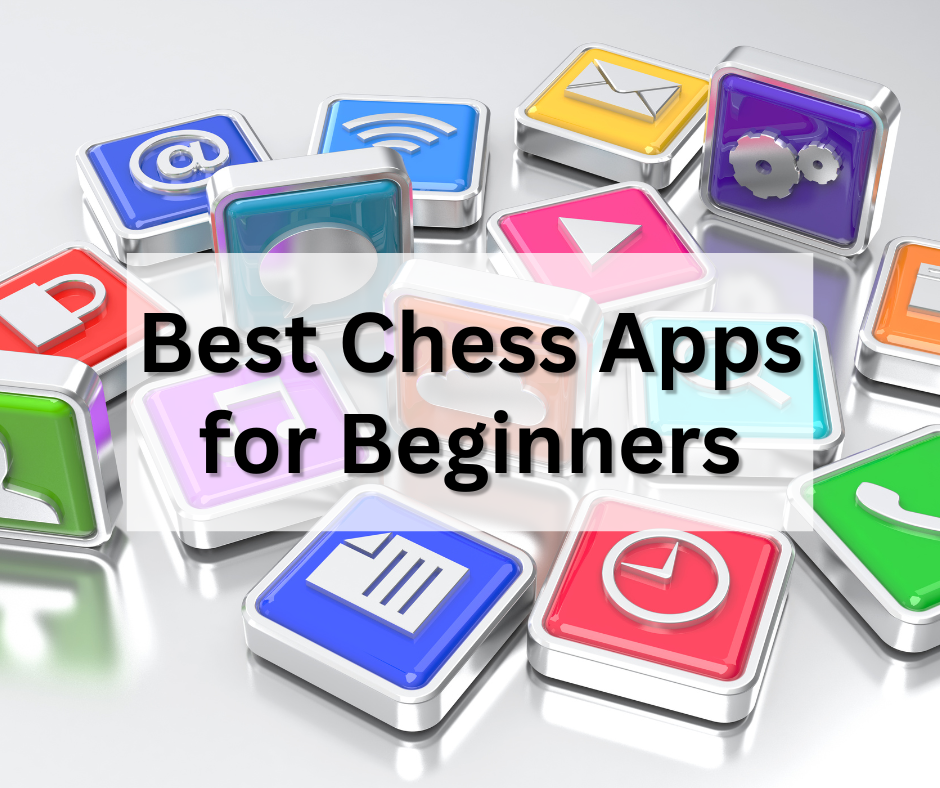
When I started playing chess over 50 years ago, the internet didn’t exist. Computers existed, but only in the basements of government offices and large businesses. Back then, if you didn’t have a coach, then books were your only option for improving your chess skills.
Today you have access to tons of chess apps on your phone, tablet, laptop or desktop computer. This is great, but the volume of choices makes it hard to know which ones are best, especially for beginners.
So I present to you my list of top ten apps that I wish I’d had when I started chess. These are my own opinions, and they are subject to change as new technologies emerge.
I should also note that I’m using a broad definition of the word “app”. I am including both mobile device apps, plus web-based applications and sites. I would have included desktop apps, but most of those have fallen by the wayside in the last ten years or so.
Here’s my list:
Try these on your own, or read on to find out why I like them, and how they might help your chess improvement. Armed with this knowledge, you can decide which ones make the most sense for you.
Contents
You can’t have a discussion about chess apps without mentioning Chess.com. After all, it’s the most popular chess platform in the world. Chess.com offers an incredible range of features for players of all levels.
One of the best ways to improve at chess is by playing real opponents, and Chess.com makes this easy. The app allows you to play games with players from around the world at different time controls. These include bullet (1-minute games), rapid, classical. There is even the option to play “daily” games where moves are once a day or longer. You can customize your opponent’s rating range to match with players at your skill level. This makes it a perfect platform for beginners to practice.
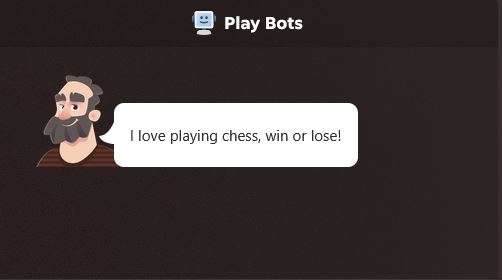
Not ready to face real opponents? Chess.com offers a variety of bots that mimic different play-styles and skill levels. Start with a beginner bot that makes simple mistakes. When you master those, move up to stronger AI opponents. Some bots even have personalities that mimic historical grandmasters or fictional characters.
Chess.com features a vast collection of video lessons by top GMs, IMs, and chess coaches. They cover everything from the basics of piece movement to advanced positional strategy.
Interactive lessons on Chess.com allow you to learn by doing. These lessons walk you through concepts move by move, asking you to make decisions along the way. You get instant feedback, explaining why certain moves are better than others. This is crucial for beginners trying to build good habits.
Chess.com hosts thousands of tournaments daily, from beginners’ events to high-level competitions. You can join arena tournaments, Swiss tournaments, and daily chess events. Participating in tournaments is a great way for beginners to gain experience.
The Chess.com forums provide a space where players can discuss everything chess-related. If you have questions, the community is always ready to help. It’s an excellent resource for both beginners and experienced players.
Joining a club on Chess.com allows you to connect with players who share your interests. There are clubs dedicated to all manner of topics. These include specific openings, national chess federations, and even casual groups. Joining a club also gives you access to private tournaments and team matches.
Tactics are the foundation of chess mastery. Chess.com offers a tactics trainer that lets you practice solving puzzles at your level. The platform also provides specialized drills for endgames, checkmating patterns, and visualization exercises. These features are perfect for beginners who want to develop their chess skills.
Chess.com provides an extensive game library of both historical and modern games. The opening database allows you to explore different openings. You can even see top players’ preferences. This lets you study the typical plans associated with each opening. This feature is especially useful for beginners trying to learn specific openings.
Love watching top-level chess? Chess.com offers live coverage of major tournaments. , including the World Chess Championship, Candidates Tournament, and Chess Olympiad. You can watch games with real-time analysis and expert commentary.
Chess.com provides most of its core features for free. This includes games, limited puzzles, and limited video lessons. To unlock the full versions of all features, you’ll need a premium subscription. The paid tiers offer increasing levels of access to exclusive content and tools. But even without a subscription, it remains one of the best chess resources for beginners.
If you’re looking for a free, high-quality chess app, Lichess is an outstanding choice. It offers most of the same features as Chess.com, but with one major difference: they’re all free. That’s right—no premium memberships, no locked features, and no ads. Lichess runs on donations from the chess community. This keeps it accessible and inclusive for all players.
Like Chess.com, Lichess lets you play games against players at a variety of time controls. You can also challenge AI opponents at different difficulty levels. Don’t expect the same “personality” or chat you get from Chess.com bots, though.
Lichess offers interactive lessons for beginners, a curated library of YouTube videos. They also have a tactics trainer with different modes for targeted practice. These tools are effective for sharpening your skills—and they’re all free.
Beginners can join tournaments, including arena-style events that are fast-paced and fun. There are also team battles and thematic tournaments based on specific openings. Diving into tournaments is an excellent way to challenge yourself and improve.
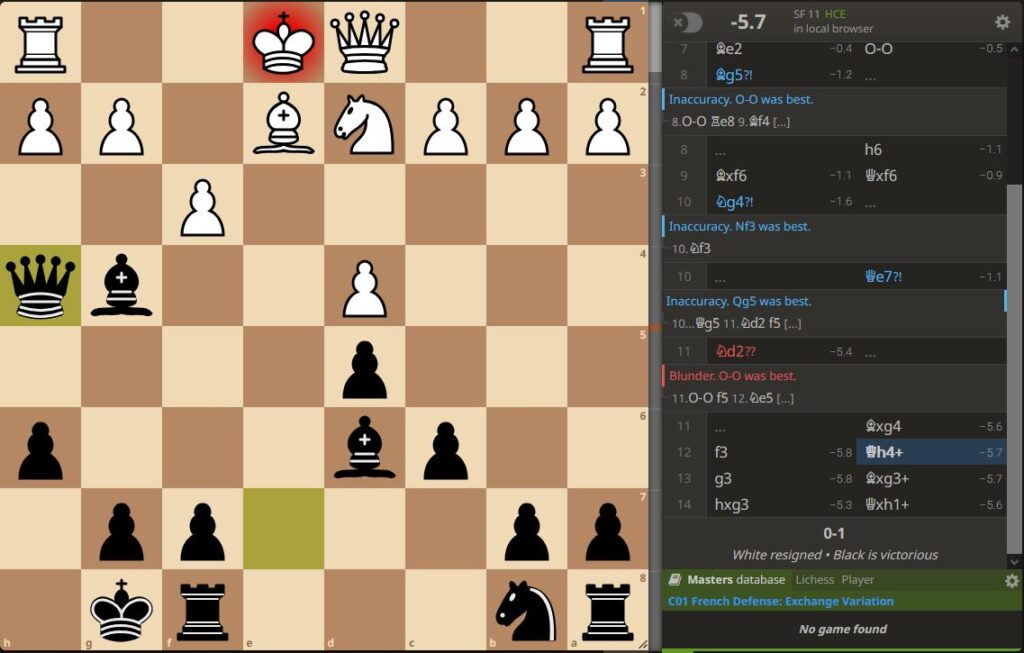
After every game, use Lichess’s free cloud analysis tool to review your moves. Spot blunders, correct errors, and get feedback from a powerful engine. The opening explorer lets you study various lines and build your opening repertoire.
Lichess offers teams, forums, and study groups, connect you with like-minded players. The study feature is particularly useful. It lets users create and share interactive lessons, annotated games, and custom puzzles.
Lichess also covers live chess events and major tournaments. Follow along and learn from the best.
To me, the most appealing aspect of Lichess is its commitment to being 100% free for everyone. Unlike other platforms, you don’t pay for deep analysis or unlimited puzzles. Lichess is an ideal platform for beginners who want top-tier chess tools without the cost.
Lichess delivers professional-level chess training and game play in a completely free package.
If you’re introducing chess to a younger child, ChessKid is one of the best apps available. Run by the team behind Chess.com, ChessKid makes learning chess fun, safe, and engaging for kids. It offers many of the same features as Chess.com, like puzzles, lessons, and the ability to play games. It’s a playful package that prioritizes safety, simplicity, and entertainment.
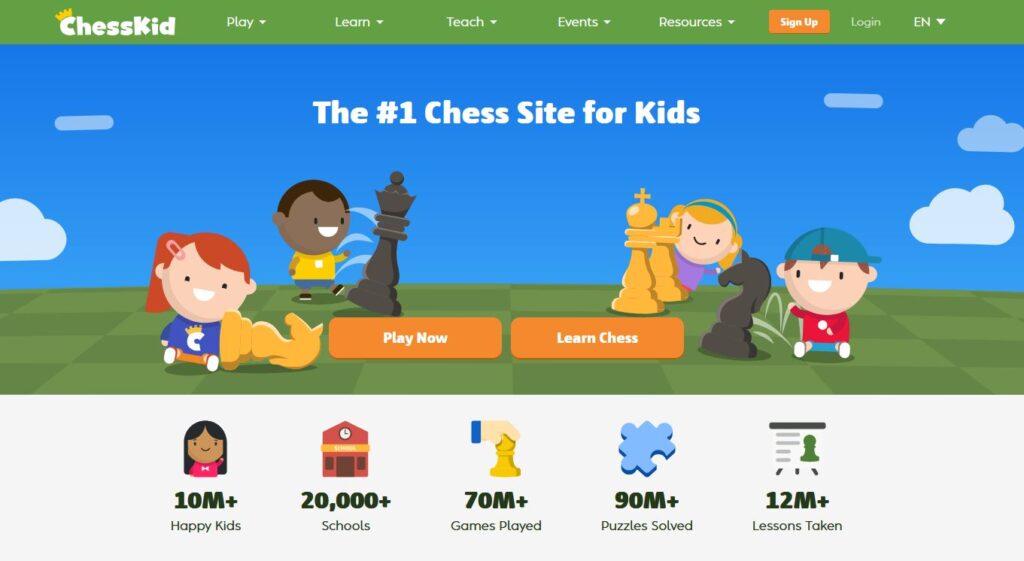
Like Chess.com, ChessKid requires a premium subscription to unlock all features. These include unlimited puzzles, full lesson access, and advanced game analysis. But even with a free account, kids can play games, do basic puzzles, and access starter lessons.
ChessKid’s interface is colorful, cartoon-like, and packed with animations and sound effects. This is great for keeping children engaged, but teens and adults may find it off-putting. It’s worth noting, though, that you can turn off the sound effects.
One of the platform’s strongest features is its robust safety system. There are no ads, no foul language, and no open chat with strangers. The app moderates communication to protect children from abuse and inappropriate content. Parents can control their child’s account, setting limits on interactions and activities.
ChessKid isn’t only for home use—it also has dedicated tools for coaches and school programs. Teachers can create student accounts, assign lessons, track progress, and host online tournaments. ChessKid is a popular choice for chess clubs and school curriculums around the world.
Chessable is a unique chess learning platform that focuses on lessons and drills. It promotes deep retention through a science-backed method called spaced repetition. Unlike apps designed for playing games, Chessable is all about learning and memorization. This makes it a powerful tool for beginners who want to build a solid foundation.
Chessable offers a wide range of free lessons. They cover everything from opening principles to basic tactics and endgames. Many of these free lessons serve as teasers for more in-depth paid courses. This lets you try out material before committing. Promotions and bundles make it possible to access premium content at discounted prices.
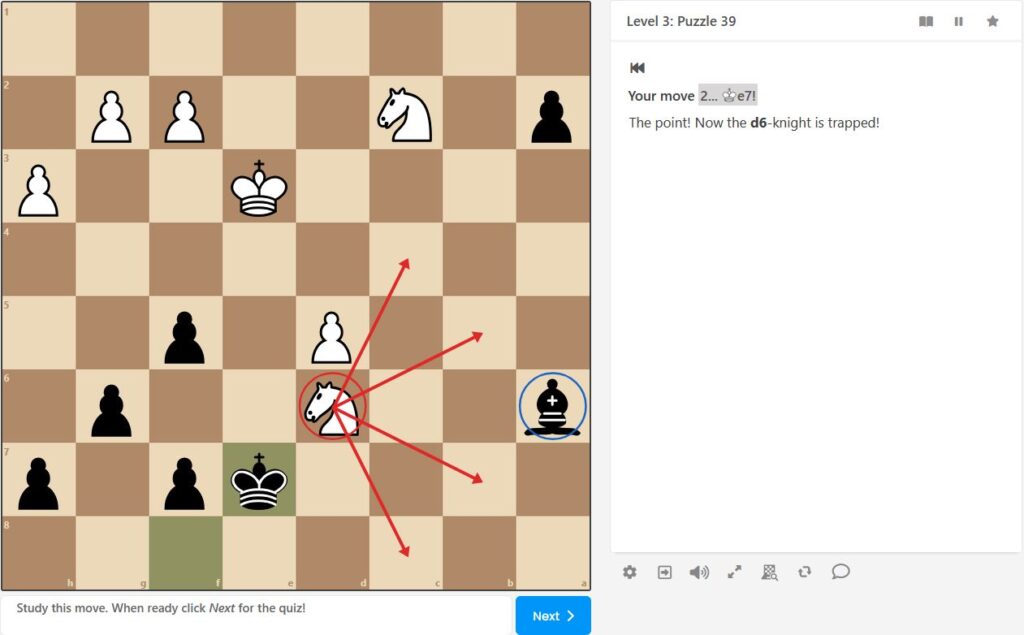
What sets Chessable apart is its spaced repetition system. This method helps learners lock in knowledge by revisiting material at optimal intervals. Whatever you’re studying, Chessable’s system ensures you do more than learn it—you remember it. For beginners, this can be a literal game-changer.
Chessable boasts an impressive library of lessons by some of the biggest names in chess. You’ll find courses by players like GM Magnus Carlsen, GM Anish Giri, and IM John Bartholomew. Topics cover everything from beginner basics to advanced strategies. Learning straight from top-tier talent ensures that you’re getting reliable, high-quality instruction.
My favorite Chessable’s feature is the ability to create your own custom courses for personal use. You can build a repertoire by entering your favorite openings. Or set up puzzles you want to practice Or drill specific endgame scenarios. This focused training makes it easy to target your weaknesses.
The ability to evaluate a position is one of the most underappreciated skills in chess. In other words, to understand whether White, Black, or neither has an advantage, and by how much. Strong positional evaluation helps guide better decisions.
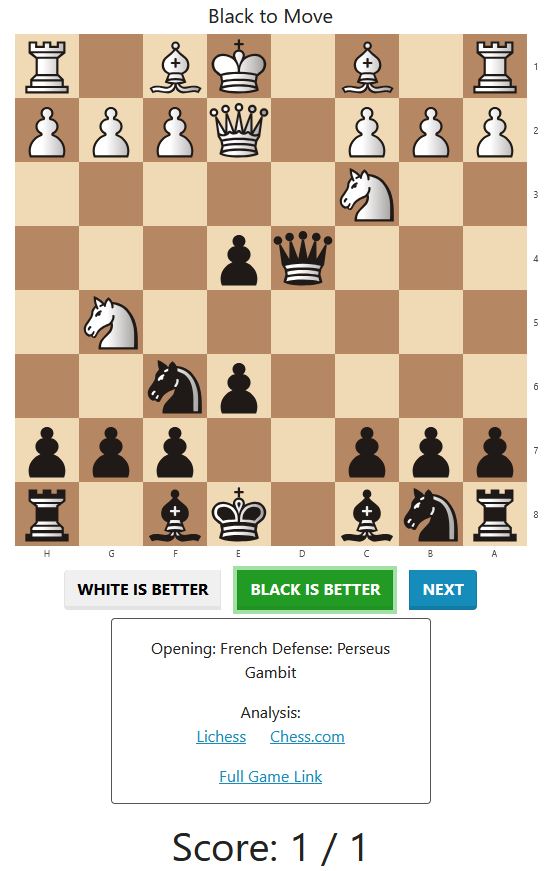
Decisions like choosing the right plan, trading pieces, or avoiding blunders. Yet, this skill is rarely practiced in isolation. That’s where ChessEvaluationTraining.com comes in.
This free, no-frills website focuses on training your evaluation skills. It presents you with random chess positions and asks you to decide which side is better. Submit your answer, and you receive instant feedback based on engine analysis. This helps you refine your positional judgment over time.
What makes this tool especially useful is its simplicity and focus—it does one thing, and does it well. There are no ads, no distractions, and no paywalls. Each position also includes links to analyze the position on Lichess or Chess.com. If you want to dive deeper you can explore the position in more detail. This helps reinforce accurate evaluations and correct faulty thinking.
Want to develop your positional intuition? Then ChessEvaluationTraining.com is a unique and vital tool. It’s the only site I’ve found that’s dedicated to drilling this essential skill. Best of all, it’s completely free.
YouTube is one of the most accessible and diverse resources available on any topic. No matter what level you are, YouTube offers thousands of hours of free content. Subjects run from opening guides to tactical puzzles, game analysis, and grandmaster commentary.
The beauty of YouTube is that you can explore the topics that interest you most. You can also seek different teaching styles to find what clicks best for you.
Here are some of my favorite YouTube channels, each with its own strengths:
GothamChess is the most popular chess YouTube channel today. It’s known for its entertaining, beginner-friendly content. IM Levy Rozman breaks down games with humor and clarity. Plus, he makes complex ideas approachable. His series like “Rating Climb” and “Guess the Elo” are perfect for newer players. They offer insights into common mistakes and improvement tips. Levy also reviews historic games, trends, and chess news.
GM Igor Smirnov’s channel focuses on structured, strategic learning. His lessons often delve into positional play, planning, and attacking principles. He employs a calm, methodical, and sometimes humorous teaching style.
Beginners will appreciate how he breaks down concepts step-by-step. He also often shares complete opening systems you can start using immediately.
Dr. Can’s Chess Clinic offers a unique mix of practical advice and coaching insights. His channel is especially good at focusing on common errors, which he calls “chess crimes”. His practical tips are immediately useful for club-level and beginner players.
He also presents psychological aspects of chess, such as how to avoid blunders. By focusing on the “why” behind each move, he imparts chess wisdom like magic.
Chess Talk is well-known for its crytal-clear lessons. They often focusing on specific openings, tactical tricks, and chess basics. It’s a great starting point for beginners who want simple, no-nonsense explanations. The channel often summarizes complex ideas in short, digestible videos. This makes it easy to pick up new skills in a flash.
Hanging Pawns offers deep-dive opening series, strategic guides, and positional play lessons. The creator, Stjepan Tomić, has a calm and thoughtful teaching style. His channel is ideal for players who want to understand deeper strategy. Plus, his opening repertoires for beginners are particularly popular.
Many of these channels also advertise premium courses. This is great for players who want to go deeper into specific topics. Examples include mastering specific openings or building an endgame toolkit. These paid resources provide details that you won’t find in free content. They can be a smart investment if you’re serious about improving your game in a focused, efficient way.
YouTube is a goldmine for chess learners. It offers a wide variety of free content tailored to different learning styles and goals. These channels can speed up your chess growth, and keep you inspired along the way.
I’m a big believer in paid courses. Sure, there’s a wealth of free chess content out there. But paid chess courses offer a level of structure, depth, and focus that make a big difference.
The best courses come from experienced coaches and titled players. They should include both step-by-step lessons, and practical exercises or drills. The most common presentation is either video or interactive board, sometimes both.
Two popular platforms with paid content are Chessable and ChessMood.
As mentioned earlier, Chessable is a powerful learning tool. It combines interactive lessons with spaced repetition to help you internalize knowledge. The site covers thousands of topics, including openings, tactics, strategy and endgames. Many of these are by top-level grandmasters and renowned coaches.
The courses often combine video instruction, text explanations, and interactive drills. Chessable’s paid content lets you go beyond the basics and dive deep into specific topics.
ChessMood is a subscription-based training portal, but you can start with the basic (free) plan. It offers a comprehensive curriculum aimed at achieving your next rating goal. It includes hundreds of hours of video lessons, live classes, and webinars. There is also a supportive community of learners and coaches.
The platform is especially well-regarded for its opening repertoires. tailored to different levels and its focus on training mindset and practical play. ChessMood is ideal for players who want a guided, all-in-one learning environment.
Many individual chess teachers offer standalone courses as well. For example, Remote Chess Academy by GM Igor Smirnov features a wide selection of courses. They cover topics like attacking play, positional understanding, and opening mastery. Smirnov is well-known for his clear, methodical teaching style. This makes his courses particularly helpful for beginner and intermediate players.

Other coaches and titled players also sell niche courses through their own websites. Others sell on platforms like Udemy, Teachable, or Thinkific. These can be a great option if you’re looking to improve a specific part of your game.
If you’re serious about improving, courses can offer a faster, more focused path to progress. Free videos are often scattered or generic, and designed to get the click. Paid courses have to deliver. That means they tend to be comprehensive and well-structured.
Investing in the right course can help you reach your goals faster.
If you enjoy Gotham Chess and his fun, approachable teaching style, check out Chessly. Rozman’s new chess training site offers a comprehensive learning experience. It combines videos and interactive drills to help players train key chess skills.

Chessly uses an “all-you-can-eat buffet” model. Many other platforms sell individual courses à la carte. Chessly gives you access to everything for a subscription fee. That means you can explore all the topics at your leisure. It’s all yours, without having to worry about pay for each item.
The platform is ideal for beginners and intermediate players. The video lessons are easy to follow, with Levy’s signature mix of clear explanations and humor. This makes learning feel less like a chore and more like an enjoyable experience. After each lesson, you can reinforce your knowledge with interactive drills. This ensures that the concepts are actually practiced and absorbed.
Aimchess is a fantastic tool for creating a personalized training experience. The app scans your games from Chess.com and Lichess for errors. It uses these to identify recurring weaknesses. Then it generates targeted learning puzzles based on your own play.
This is huge. It means you’re not solving random tactics. —you’re working on specific issues that are holding back your progress.
The basic features of Aimchess are free. This makes it easy to try it out and get value from without any upfront commitment. If you want unlimited access to all features you can upgrade to a paid account. That said, many players will get plenty of value from the free version alone.
One of Aimchess’s standout features is the “Find the Best Move” drill. Unlike typical tactics puzzles, these positions often call for quiet positional moves. Or they might call for defensive ideas, or strategic planning. This exercise is much closer to a real games situation.
I use Aimchess as a daily warm-up, as it helps get me into a focused, game-ready mindset. If you want to train smarter, Aimchess is a powerful tool.
I recently discovered DecodeChess by accident. In a short time it become one of my favorite free resources for game analysis and improvement. Like Chess.com and Lichess, DecodeChess can analyze your games. Like the big guys, it points out blunders, inaccuracies, and missed opportunities. But DecodeChess goes further. It actually explains the reasoning behind each move in human terms.
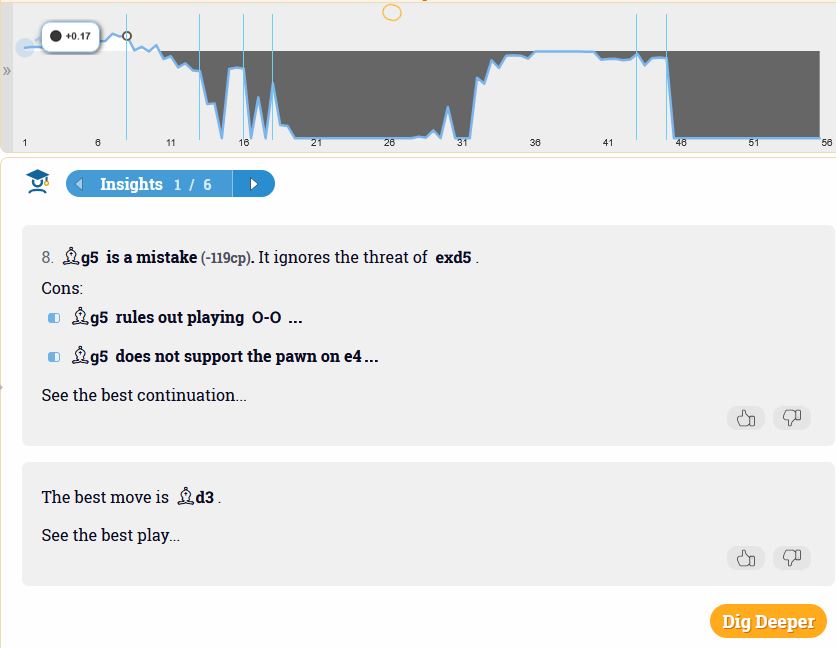
This is a game-changer. Understanding why a move is bad—or good—is the key to lasting improvement. It’s not enough to know you blundered. You need to understand the tactical or strategic ideas that made your move weak. And you need to know what you should have done instead.
DecodeChess provides that insight. It acts as a virtual chess coach that walks you through the thought process behind each decision. That’s something that traditional engines don’t do.
Think of this app as an AI chess tutor—because that’s exactly what it is. It bridges the gap between raw computer evaluations and human understanding. And it helps players at all levels learn from their own games with less confusion.
DecodeChess uses a subscription model for unlimited analysis. The free version lets you analyze a few games, which is more than enough to get a feel for its value. Even without a subscription, you can learn a lot from a handful of deep dives into your recent games.
Don’t overlook this resource. Especially if you’re serious about learning from your mistakes.
With so many excellent chess apps and websites, it can feel overwhelming to decide where to start. The good news is—you don’t need to use all these resources to improve your game. In fact, trying to juggle them all might do more harm than good. Instead, pick a couple that suit your learning style and goals. Then stick with them.
That said, using more than one resource is definitely a good idea. No single app offers everything. Some are better for playing, others for training. Still others are better for analyzing and learning from your own games.
I’ve highlighted a wide variety of tools, but I’m sure there are great apps and sites I’ve missed. If you know of a resource that’s helped you as a beginner, drop a comment below and share your experience. Likewise you have thoughts about any of the ones I’ve mentioned. Let’s help each other grow and build a stronger community of fearless chess learners.